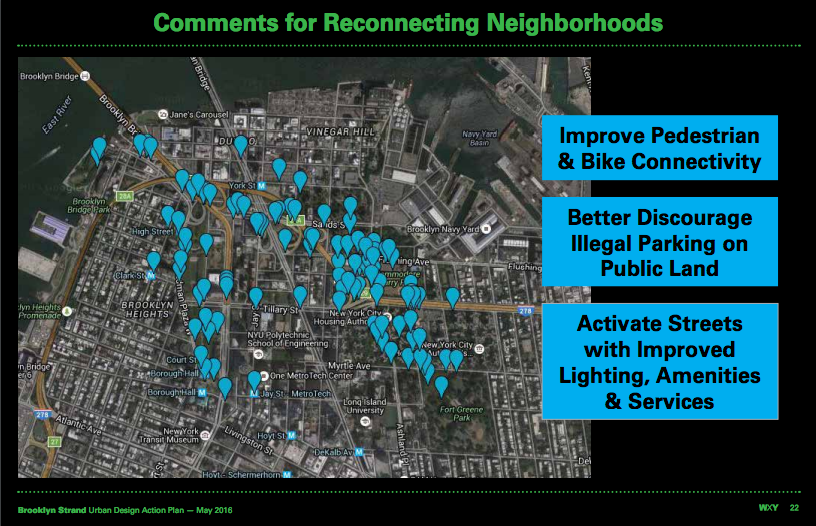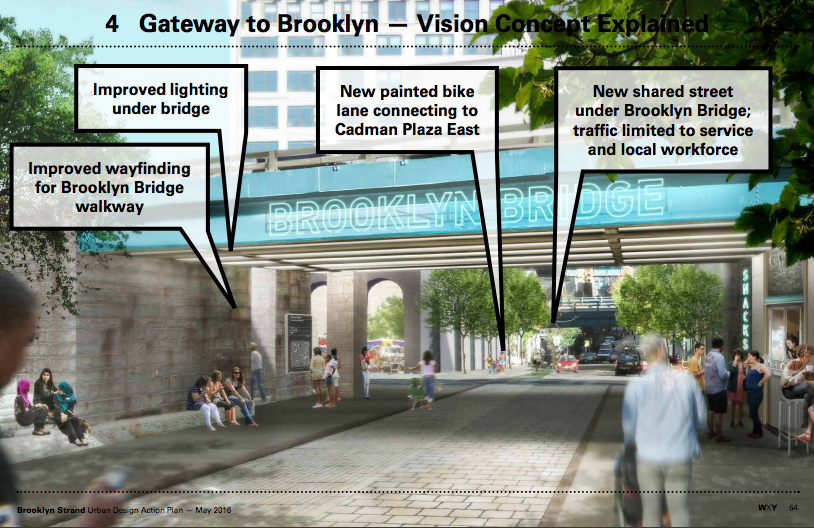

Image: Brooklyn Strand Urban Design Action Plan, Slide 2.
Project Profile: The Brooklyn Strand Action Plan
By Emma Ng
We often think of public projects as mammoth undertakings that come about at the will of city agencies and officials, but in New York, there are projects in which residents (as individuals, groups, and communities) are highly involved in imagining what is possible for the spaces they share. There’s the philanthropist-with-a-vision model of Barry Diller and Pier 55, the “Kickstarter Urbanism” of projects like the Lowline and the Plus Pool, and educational ecology programs such as the Billion Oyster Project. There’s also speculative proposals that are pitched to the city by communities, like the Brooklyn Strand Action Plan, and “community-led” projects facilitated by the Design Trust, as highlighted in our interviews with the El-Space and Future Culture Fellows.
Each of these initiatives is driven by the desire of residents to take part in originating and developing civic projects. Each also tests a different model for participation, with their possibilities and limitations becoming clearer as they progress.
Brooklyn communities were actively involved in the process of visualizing change in the development of the Brooklyn Strand Action Plan. The City presented an idea–and a group of community partners, including the Downtown Brooklyn Partnership and Brooklyn Bridge Park, seized upon this as an opportunity for residents to imagine how their spaces might better serve them.
In 2014, Mayor Bill de Blasio announced a series of initiatives designed to reinvigorate Downtown Brooklyn. Among these was the idea of “reinventing the Brooklyn Strand”–connecting the Brooklyn waterfront with the downtown area by linking the neighborhood’s (currently fragmented) plazas and green spaces.
An organized community response culminated in the presentation of the Action Plan (a “Community Vision” for a reimagined Brooklyn Strand) to the City in 2015. Led by the architecture firm WXY, over 50 stakeholder groups from Downtown Brooklyn were involved in a two-year process of site walkthroughs, public workshops, and meetings with individuals and organizations.
The Brooklyn Strand Action Plan features five objectives: reconnecting neighborhoods, advancing public space equity, crafting a gateway to Brooklyn, improving park access, and exploring economic opportunities.
The community fed in suggestions and observations, which were compiled and mapped. Common themes that emerged included: improving pedestrian and bike connectivity, removing fences to create better park access, and incorporating more amenities.

The mapping of comments and suggestions related to the objective of “Reconnecting Neighborhoods”, Brooklyn Strand Urban Design Action Plan, Slide 23

Recommendations for the Brooklyn Bridge exit, Brooklyn Strand Urban Design Action Plan, Slide 54.
The Plan’s recommendations range from the ambitious to the modest and include both long- and short-term suggestions. For example, the plan suggests that the pedestrian “gateway” to Brooklyn–coming off the Brooklyn Bridge–could be made safer and more hospitable through the introduction of better signage and lighting (relatively small-scale improvements) or the raising of Cadman Plaza Park to meet a new promenade access bridge (a fairly large change).
Having been handed over to the City, the future of the Plan is yet to be determined. It remains to be seen how many of the recommendations will become a reality, but the Brooklyn Strand Action Plan is an example of how a community vision can be developed if the agendas of multiple groups align. The process of developing the conceptual plan also sketches out a role for architects and designers as community advocates. WXY helped guide the community through complex city processes, taking their ideas and shaping them into a form that can be fed back into City agencies (that are sometimes otherwise difficult for individual residents to access and navigate). It’s a design process that squarely positions residents–not just the City–as the client.
In a national climate of political uncertainty, the past six months have seen a renewed focus on local-scale initiatives. Directing energy toward the local offers individuals important opportunities to take action, feel empowered, and effect change within their communities. It’s in this highly charged context that the community-oriented process of developing the Brooklyn Strand Action Plan is worth revisiting. It offers one among many glimmers of hope and possibility–modeling a potential avenue for communities to become agents, rather than mere recipients, of urban change.
See the Brooklyn Strand Action Plan on the WXY website, or view the complete set of recommendations here.

地址: 北京市 东城区 青龙胡同1号歌华大厦A座8层
邮编: 100007
电话: 010 84186820
邮箱: info@bjdw.org




